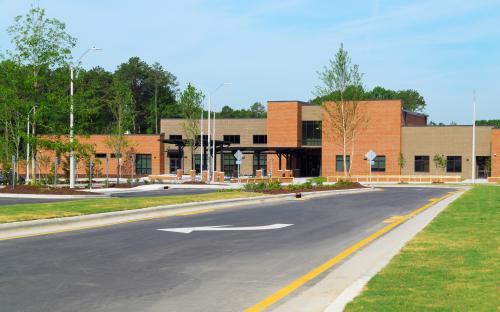More than 25 million students in the United States—more than half of all students—ride a school bus. Although the iconic vehicle may conjure images of nostalgia for many, the use of diesel fuel and an aging fleet mean these buses are some of the most polluting vehicles on the road. New research is piling up demonstrating the causal link between short- and long-term exposure to air pollution, especially particulate matter, on cognitive functioning and even the risk of dementia. One might begin to wonder about the effects of pollution from school buses on children, who are highly sensitive to dirty air.
Study design
We examined this question in a recently published study. We tested whether diesel emissions from school buses impact academic performance and respiratory health by studying 2,656 school bus engine retrofits in the state of Georgia from 2007 to 2017. These retrofits are relatively cheap engine modifications that filter harmful pollutants, reducing some types of emissions by over 95%. We measured academic performance using English and math standardized test scores. We used a measure of respiratory health called aerobic capacity, which is assessed for Georgia students with another kind of standardized test (a “down and back” running exercise). In any given year, approximately 750,000 Georgia students are represented in our sample of standardized test scores or fitness assessments.
Our research design measures changes over time in academic performance and health across districts, comparing districts that received more or fewer (or no) school bus retrofits. For example, some districts retrofitted half of their buses, others retrofitted only 10%, while still others retrofitted none. We then asked whether districts that retrofitted more buses saw larger improvements in health and test scores.
One might worry that districts that retrofit buses are different in some way than those that do not. For example, they may care more about student health—and implement other initiatives, perhaps unrelated to buses, that improve health. Our research design dealt with this in two ways. First, by observing changes across districts over time we removed anything about districts that doesn’t vary over time, like preferences for health or general teaching quality. Second, we employed a placebo test by also checking for changes in students’ body mass index (BMI). If retrofitting districts were just getting healthier anyway, we would also see changes in BMI. We wouldn’t, however, expect bus retrofits to directly affect BMI.
Results
We saw significant improvements in students’ respiratory health. Retrofitting districts saw a sizable increase in aerobic capacity scores. The effect was twice as large when we restricted the sample to elementary-school students, who are more affected by air pollution than their older peers. We did not see any effect on our placebo outcome of BMI. Previous work has shown that students with asthma and other respiratory conditions are vulnerable to school bus pollution, but our study is the first to show that health effects of school bus pollution arise for students without these conditions.
Just like with health outcomes, we found strong and convincing evidence that school bus retrofits led to improvements in academic performance, particularly for English test scores. Based on our estimates, if a district retrofits its entire bus fleet, the effect on English test scores would be slightly larger than the effect of going from a rookie teacher to one with five years of experience. Comparing our results to those of another study looking at pollution and test scores, retrofitting an entire district’s fleet is at least as effective as moving all students from a district with average air pollution levels to one with air pollution levels in the 10th percentile.
The effect on math test scores is about half as large as that for English and is not quite statistically significant. This is consistent with prior work showing that math scores tend to be less affected by air pollution than English scores.
Policy relevance
Our findings, along with those from other studies, make the case that investments in cleaner school buses yield health and academic benefits. But are these investments cost effective? To answer this we assigned monetary values to the benefits of improved test scores and respiratory health based on previous studies.
We estimated that the lifetime net present value from improved academic test scores (for example via higher earnings) from retrofitting 10% of an average district’s bus fleet is approximately $2.5 million, while the value of improving aerobic capacity (for example, through improved health) is $950,000. On the other hand, the cost of retrofitting 10% of an average district’s bus fleet is only $90,000, a small fraction of either expected benefit.
We also contrasted the cost effectiveness of improving test scores through retrofitting buses to that from reducing class sizes. The cost per gain in standardized test percentile point is three to five times higher for class size reductions than for school bus retrofits. That is, a school district wishing to improve test scores can do so more cheaply by retrofitting school buses than by reducing class sizes.
The results of our cost-benefit and cost-effectiveness analyses are straightforward. Districts can perform relatively cheap bus engine retrofits to meaningfully increase student health and academic performance. This is a cost-effective (and overlooked) method that districts have for improving student academic achievement and health.





Commentary
Fixing school buses is an effective (and cheap) way to improve students’ health and academic performance
Monday, April 22, 2019